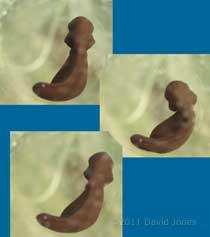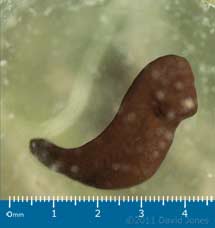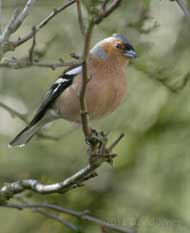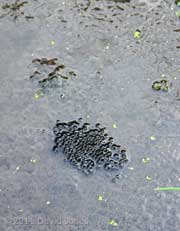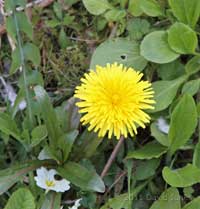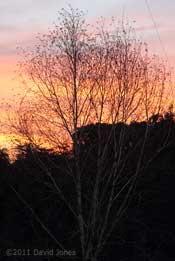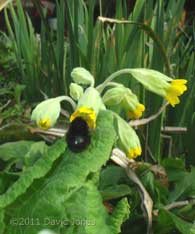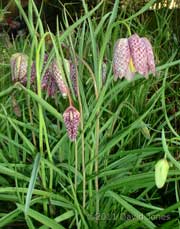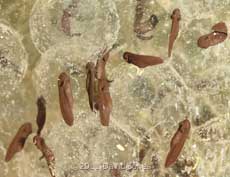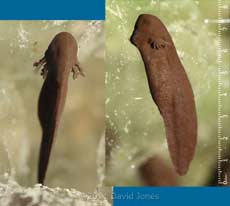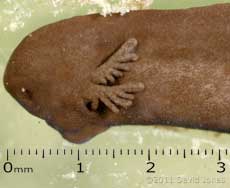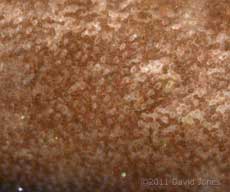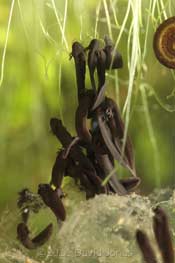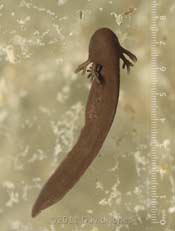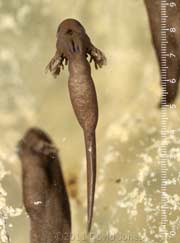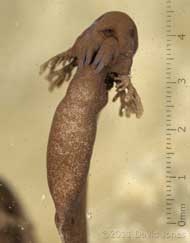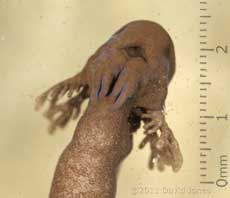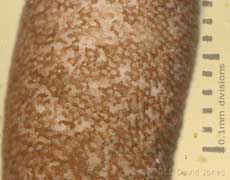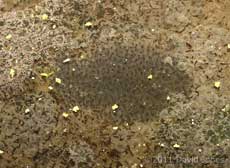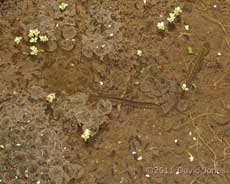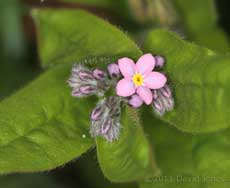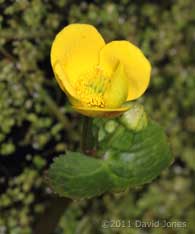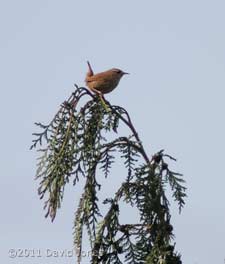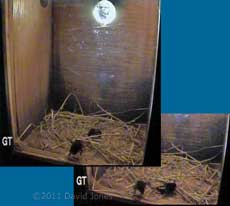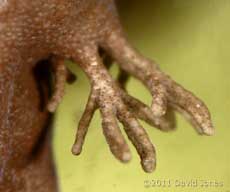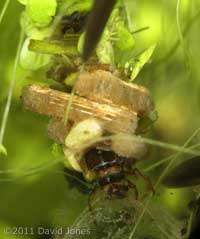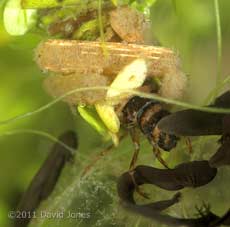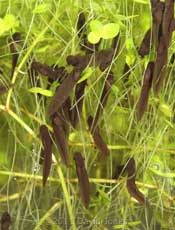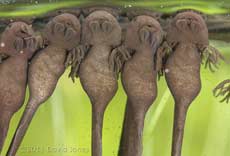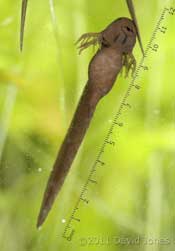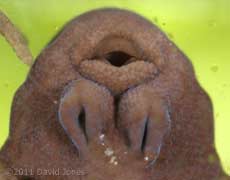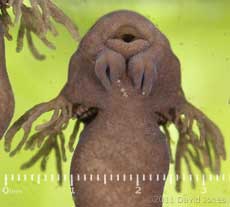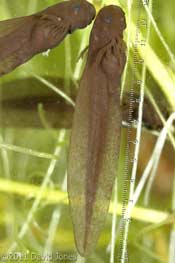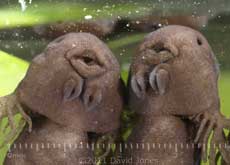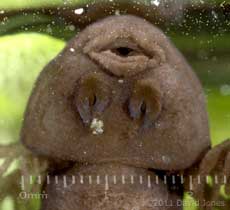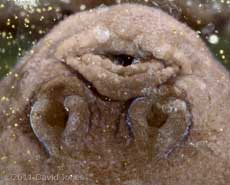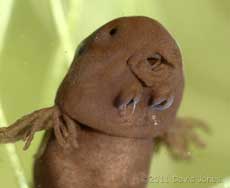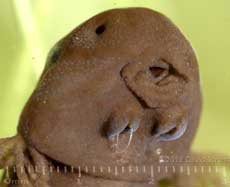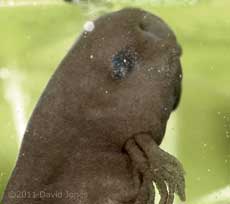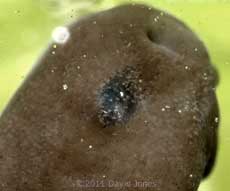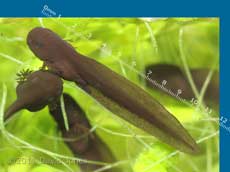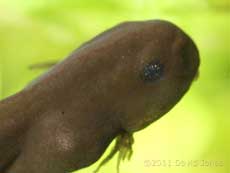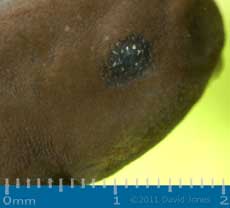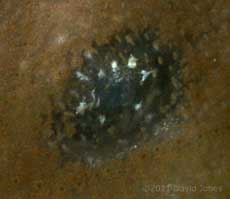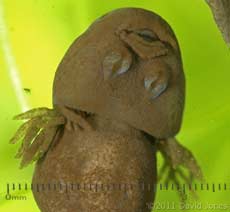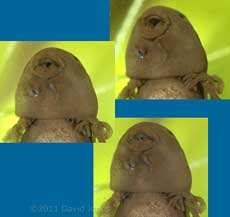Go to the last entry on this page .....Go to previous entry23 March - The sunny Spring weather continues, with a high of 16C right through the morning. That part of the day was largely given over to hosting our grand-daughters. Once I saw that the sun was shining on the pond I went outside with Erin to look at the developing frogspawn. She then headed down to the big pond, croaking as she went to accompany the real croaking that she could hear. The highlight came when she was able to crouch down not much more than a foot away from a frog that was puffing out its throat as it called loudly and repeatedly - the first time she has seen this and been old enough to enjoy the moment!
The tail has elongated since yesterday, and the 'elephant's ear' is less
pronounced now. 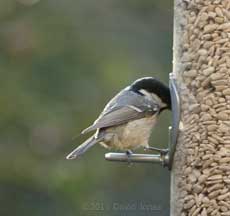 There were a couple of long absent bird visitors today. Just after breakfast I spotted a male Blackcap in the Birch tree. It is the first Blackcap I've seen here since February last year.
This Coal tit turned up at the feeder in the late afternoon and I wasn't
quick enough to get a clear picture of it. I waited for a while but it
didn't return. The last time I recorded a Coal Tit here was last October.
There were no visitors to the Great Tit box today, but a solitary male Great
Tit turned up here and took a few pecks at the fat balls hanging in the
Hawthorn. It didn't go the the sunflower feeder, which makes me wonder if it
could be a different male. Our regular GT always chose the sunflowers rather
than the fat balls.
24 March - It continues to get warmer, with a high of 17C this afternoon. It was a beautiful day, although the sunshine outside was tempered by a touch of dampness indoors! There was a cry of 'I can't get any hot water' emanated from the bathroom first thing, and a quick check confirmed that the water pressure in our central heating system had dropped to zero. There followed a check around the house for leaks in the system. Fortunately there were no wet ceilings, and eventually using a cctv camera allowed me to pinpoint the problem to a bypass valve under the floor of our hallway. As our morning was taken up with taking grand-daughter Erin to a music/singing session, it was the afternoon before the leak could be tackled - needing a 12p washer (clearly over-priced!). Erin's dad helped out with putting things back together and everything now seems to be in order again.
Just one new flower opened today - our first Dandelion of the year!
The day ended with an explosion of colour in the western sky, and after the sun had set it was still around 12C at approaching 7pm.
Yesterday I mentioned bumblebees, but what I didn't say was that queens have visited the Great Tit box several times during the week, and one inspected the Swift box SW-ri this afternoon.
25 March - What a beautiful day, with blue skies from start to finish and with the temperature easily in excess of 20C in the garden this afternoon (although the official high in Farnborough was 19C) We were away from home all morning, and while we relaxed over coffee we saw our first butterflies of the year - two Brimstones. We were also entertained by a female Blackbird clearing out what appeared to be an old nest site. My afternoon was taken up doing some grand-daughter related woodwork, and a Brimstone fluttered past me then too. Another first of the year - I was in shorts and sandals!
While I didn't have a camera handy then, I did have my small Olympus to hand when I spotted the small black bumblebee darting between the Cowslips. This is a species we see here every Spring, and which usually eludes my camera. This isn't a brilliant shot, but it is enough to confirm the sighting!
The camera was out because I wanted to record the opening of the first of our Snake's Head Fritillaries. It looks as though we will have a good crop of them this year.
By this evening there were groups of them gathering on top of the jelly mass but still clinging to it by the use of mucus glands. At this stage, and probably for the next week they will be relying on yolk for nutrition.
Each tadpole is now sporting a set of external gills (actually three pairs).
When you look more closely at the tadpole it is possible to see that its colour is far from uniform, with the areas of pigmentation giving it a speckled appearance in places. The small indentation below the front of the head is an olfactory pit which is still in the process of developing into a nostril.
This is a cropped version of the above photograph, showing the pattern of pigmentation in the area just behind the gills. The image isn't as sharp as I would have wished for - I'm afraid that failed to ensure that the outside of the tank was cleaned first!
There was increased Sparrow interest in both SW-up and SW-lo today, but there is still no sign of the Great Tits. During the day the Great Tit box was visited three times by bumbebees. I'm beginning to wonder if it would be worth putting a layer of straw into the box. If I can't tempt the birds perhaps I could offer it as a home for a colony of bumblebees. I may just do that during the weekend.
26 March - After yesterday, a mere 18C under muted sunshine in the afternoon following after a cloudy morning was a bit of an anticlimax. However it was still a case of shorts and sandals as I finished off the job I started yesterday. Just some varnishing still to do now.
It meant that for another day I didn't spend time with my camera, apart from recording the tadpoles at the end of the afternoon. Today many of the tadpoles in the tank have broken their links with the egg mass and have started climbing away from it. In this case they are using the roots of the duckweed plants.
They have now grown to between 8 - 9mm in length, with the tail being about half.
When they turn around we can now see more details of the body. Although it appears to have a mouth, this will not be open for another few days. Just behind the mouth (called a stomodeum at this stage), the deep ridges mark the position of the mucus gland.
You can see this more clearly in this next photograph. You can also see the position of the anus.
In this cropped image of the head end of the tadpole I think the blue colour seen is due to the light of the flashguns being reflected off mucus coated surfaces. At this stage I have to confess that I think it looks like some character form a alien movie!
Finally, another picture to show the pattern of pigment spots on the underside of a tadpole, this time taken through clean glass.
I should add that these tadpoles are ahead of those in the big pond which only started leaving the jelly today.
Tonight you can see these newly emerged tadpoles on the rather worst-for-wear looking spawn in the big pond, along with the 'island' of new spawn, laid two days ago.
In the pond, the young tadpoles must face an immediate danger as the newts arrive for their annual feast, and with spawning at such a low level this year, this predation could pose a real threat to the next generation of frogs.
The warm weather these last two days has encouraged the first solitary bees to emerge. I saw a couple yesterday, and today there were several flying around the bee hotels. Bumblebees were also very active today, all over the garden, so I would be surprised if we didn't have at least one nest here this year. Bumblebee visits to the Great Tit nest box this morning led to a Sod's Law moment. There were two visits around breakfast time, so with no sign of the Great Tits I decided to add some straw to the box. Needless to say, within ten minutes there was a Great Tit at the entrance! It looked in for about half a minute before leaving and didn't return during the rest of the day. In its absence there were three more bee visits. Tonight for the first time since I switched on the cctv cameras there isn't a Sparrow roosting in a Martin nest. While all the boxes are empty tonight, there was an increased level of activity in both SW-up and SW-lo this morning, although it always involved just a single bird.
27 March - Census Day, and not as warm as the past couple of days. Having said that it became sunny after a grey start when there was a touch of dampness to be seen on leaves as a result of some light rain at bed-time last night. As well as being the day of our 10-year census it was also the day of transition from GMT to BST - I think I've changed all the important clocks!
Two more flowers to add to the first-flowering tally - First, a diminutive Forget-me-not, the first of many that will flower over the coming years, sometimes with pink or blue petals.
The second is a Marsh Marigold in the big pond.
It was a good day for bird song, with Blackbird, Robin, Dunnock being the main ones, and a bit of Thrush somewhere in the neighborhood. And this afternoon they were joined by the high vocals of a Wren that flew between the tops of the conifers beyond the bottom of the garden. It's a pity I didn't get a photograph of it with its beak open.
Actually one was in the box for about two minutes before the second bee arrived. For the next two minutes their inspected it independently until their paths crossed. Then a brief tussle ensued after which one headed for the exit. The second bee left a minute later.
I set up the camera to take some more tadpole photographs, but with little in the way of obvious changes I ended up with just a picture of external gills which look so much like hands!
When I set up the tank and added a handful of duckweed I inadvertently added a Caddis Fly larva (which may be Limnephilus lunatus). Most of these larvae are omnivorous, with some carnivorous.
This one certainly seems to have a taste for young tadpoles because as I focused on it a tadpole swum into view only to be grabbed by the larva. The tadpole struggled for a moment or two before freeing itself, and after another failed attempt the larva crawled off through the duckweed. It was one of those moments when as a photographer I was disappointed by the escape!
Afterwards I took advantage of the later sunset (and the forecast of a dry night) to get the first stage of the varnishing done.
28 March - The dry weather continues (and at least for another day or two more before rain arrives from the Atlantic) with hazy sunshine and an official high of 15C at Farnborough - it felt warmer in the sunshine. I didn't pay too much attention to the garden on a day that started with breakfast with the grand-children, followed after what turned out to be a prolonged visit to the opticians (which required the dilation of my Iris, so no driving for me!), and then part two of the varnishing act. When that was all done I turned my attention to the tadpoles to see how much has changed over the last two days -
First, they are starting to spread out now, with the occasional swim as they head to another 'perch'.
I couldn't resist this group, heads tucked up into the meniscus between water and glass, and attached to that glass by the use of their mucus glands.
Individuals are now in excess of 1cm in length with a tail which is now well over half their body length. Tomorrow I must include a shot of the tail to show some detail.
The head is definitely showing progress since I took the last close-up two days ago.
The mucus glands are already starting to recede (you can also see this in the group photograph above). Once the tadpole is free-swimming these will not be needed.
The skin is covered with small bumps, apart from the lower surfaces of the mucus glands.
Moving out a little you can see how the external gills have grown larger. Notice the sets of smaller structures tucked under the larger gills. I'm not sure but I think these may represent the third pair of external gills that have remained hidden in previous photographs.
(added 5 April) - I now suspect that the small structures may actually be the early stages of the development of internal gills. While the external gills provide the oxygen supply in the early stages the tadpole is developing sets of internal gills. Under the flap of skin on each side (opercular folds) a set of four gill clefts (openings) from the tadpole's pharynx to the exterior may have already formed. If that is the case then these clefts will be developing the internal gill structures ready to replace the less efficient external gills.
Going through the day's cctv recording, there have been no birds showing any interest in the GT box, but once again there have been two Bumble Bees in there - at different times today. The number of bee visits has let me to add some more straw to the box tonight in the hope that one of the queens will decided it's a good place to nest. I forgot to mention last night that in addition to the numerous Common Garden Bumble Bees about there was also a Carder Bee flying about under our veranda roof for a while in the afternoon. Getting back to the birds, we have not had a rooster in the House Martin nest for the last three nights, and today the only activities recorded involved a single male Sparrow visiting SW-lo numerous times between 7am -12.30pm.
29 March - We were greeted by rain when our curtains were opened this morning, although by 10am it had diminished to the occasional drip and at 11.30am we had the first sunshine of the day! It didn't last, and the rest of the day remained mainly cloudy, with intermittent hazy sunshine and spots of rain from time to time. Well, it's been a week since I had my moan about cats and since then the garden has been pretty well cat free during the day and my jug of water remains full! On the bird front I haven't seen Chaffinch, Siskin nor Coal Tit since the 23rd. An update this evening - first, we were sitting down having a meal this afternoon when the male Chaffinch perched in the Hawthorn and sang for several minutes before visiting the sunflower feeder. And this evening the just of water was emptied! Activity in the nest boxes began at 7am with a Sparrow making a brief visit to SW-up before the first of many visits to SW-lo, the last of which took place at 6pm. At 11am a bird approached the entrances to SW-le and SW-ri several times before a Starling squeezed into SW-ri. It stayed only a few seconds and didn't return. Finally, at 2.30pm the GT box had another Bumble Bee visitor - just one today. The boxes are all empty tonight. No photographs today, and apart from a bit more varnishing (nearly finished now) I've more or less taken the day off.
30 March - A wet day - not heavy rain but enough to make it miserable. It's not surprising that there were no Bumble Bee visits to the nest box today. The conditions weren't conducive to much activity in the garden, but before breakfast I saw two Starlings down collecting nesting materials. When they left I watched the cctv images and the nest boxes across our road, but they went elsewhere. That's good news in as much as it means that there are other places nearby where they are able to nest. A bit later I was able to confirm that there are other Starlings going into the nest boxes across the road. The male Chaffinch came to feed several times today, as opposed to the single daily visit we've been getting up to now - still no sign of a female about. It wasn't until late afternoon that I got around to checking on the tadpoles. Today they are well and truly free swimming and have spread throughout the water in the tank.
This individual is typical of their stage of development, with a body nearing 13mm in length, with its tail over 2/3 of that length.
As this pair show, development in the head region continues apace, with the mouth more complex than two days ago as the mucus glands continue to shrink. And there is a fold of skin forming across the body between the gills.
(added 5 April) - By this stage, the opercular folds that have been starting to cover the external gills are now beginning to merge together across the ventral (lower) surface of the tadpole
Looking a bit more closely at the head of another tadpole you can see what I believe is developing into a row of rasping teeth above the lower 'lip'. While I watched it, this individual opened and closed its mouth several times. Also, notice that the mucus glands appear flattened as it uses them to cling to the glass.
I think the row of 'teeth' can be seen a bit more clearly in this example, despite the very messy state of the aquarium glass. There is a lot of algal growth spreading over the glass. While this doesn't make for good photography I'm reluctant to clean too much of it off as the tadpoles will be relying on algae for a good while yet.
This tadpole seemed to be actually drooling mucus as if to confirm that the glands are still active! This picture has raised an interesting question that I shall have to investigate further.
While much of the lower surface is marked with spots that show up blue in the light of the flash, there are a couple of bands which are free of these spots. Instead they have numerous dark spots - are these sensory pits of some sort? Why the bands? Look carefully in the bottom-left corner and you can see a single curved line of them.
In the glum conditions this afternoon I set up a lamp to one side of the tank to help with focusing. While the lamp help with that it also caused problems because the tadpoles reacted to its presence, with many of them swimming to that side of the tank. With them already active that made photography a bit of a challenge. Even using a small torch instead caused problems today, for the first time.
And this picture along with the first of the day's entry show why - the presence of functioning eyes - at least eyes that can react to the presence of bright light,
although a closer look suggests that this tadpole's eyes may not yet be fully functioning. You can see that stretched over it is skin that has pigment spots.
In the first of this last pair of pictures you can also see the row of spots that curve part the way around the external gill, and there appears to be more of these spots or pits in the area behind the eye.
31 March - The month ended with a drizzly morning that became a day with some sunshine and the odd light shower. Thanks to the rain Sparrow activities got off to a slow start this morning and only box SW-lo got multiple visits, again by just single birds. The GT box received one Bumble Bee visit just after noon. We were out all morning and this afternoon I finished the last of the varnishing that I've been working on this week. After that it was back to the tadpoles again.
There seems to have been little increase in length since yesterday, but the eyes can be seen a bit more easily and the external gills seem to be a bit smaller, although I'm not sure to what degree that is because of the flap of skin that I commented on yesterday.
The eyes still appear to have a covering of skin over them,
as you can see when you move in closer. In addition, in this picture you can once again see lines of sensory pits(?), one immediately under the eye and the other at the bottom of the image, just in front of the external gill (similar to the line I mentioned yesterday).
Zooming in even closer and behind the spots of pigment you can just make out the pupil of this eye. The slightly blue colouring is probably due to the reflection of light from the flash guns.
Looking at the underside of the head it is obvious that the mucus glands are continuing to get smaller, and in the mouth the rasping jaws are becoming more clearly defined. In this picture you can see how the bases of the external gills are now well and truly hidden by the skin fold that has developed.
(added 5 April) - It is clear that the opercular folds have now fused to form a common chamber that links the gills on the two sides of the tadpole.
This group of images of the same tadpole show that it has begun to open and close those rasping jaws, although I didn't see any tadpoles actually grazing today. Also, the mucus glands on this individual appear to be much more reduced than in the previous example.
Click on images to see larger versions
|
|
